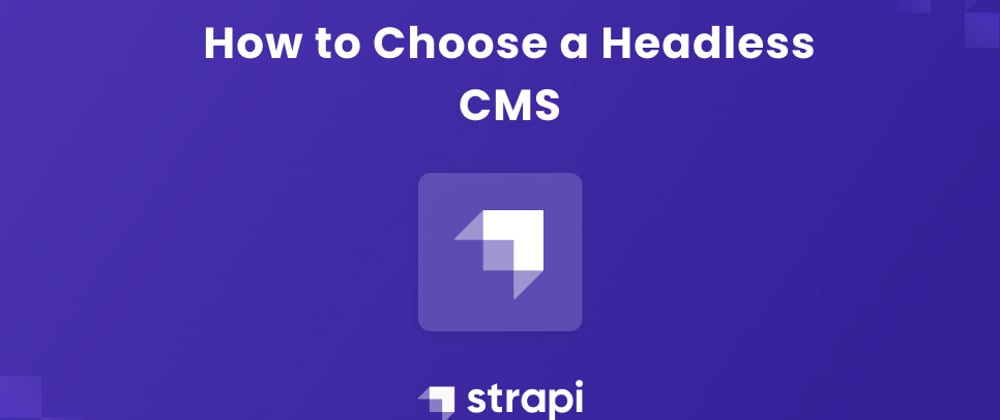As of this writing, there are 89 headless CMS that aims to address the variety of business needs for their potential customers. How can you escape choice overload and pick the right one for you?
In this article, we will look at the factors to consider when choosing a headless CMS. This way, you can pick the right headless vendor for your business, editors, marketers, and developers.
What is a Headless CMS?
A headless CMS is a backend-only content management system. Unlike a traditional CMS like WordPress, headless CMS doesn’t provide a presentation layer where your content is displayed. Instead, they act as the content repository where your data is stored.
Headless CMS is API-driven by design. They make the content accessible via RESTful and GraphQL APIs in JSON data format, which allows content delivery to your target audience through the channel of your choice.
Benefits of Using a Headless CMS
Reusability:
Headless CMS gives you omnichannel control. They provide complete control over how and where your content appears. This way, you can craft unique digital experiences for each channel without reauthoring your content since the frontend is separate from the data.
Developer Freedom:
Developers can do their best work using the tools and technologies they are familiar with. With a traditional CMS, you are constrained to working with the programming language(s) compatible with the CMS. However, since headless CMS is tech-agnostic, developers can decide what tools to use. Another benefit is developers have the freedom of switching from one tech stack to the other with ease.
Low learning curve:
Headless CMS has a low learning curve for content and development teams. For Content teams, headless CMS provides an easy-to-use interface that is often similar and sometimes better than traditional CMS.
Also, since headless CMS is API-driven, developers don’t need to learn the technologies built around the CMS, like they would with a traditional CMS. This quick-start experience for content and developer teams makes them more efficient in getting the job done.
Security:
Being API-based, with the content separated from the presentation layer, the risk of malware attacks is lower than with traditional CMS.
Rapid Content Deployment:
Headless CMS API-driven approach enables you to deliver content to new channels faster than ever.
Future-proof content:
Headless CMS integrates easily with new technologies and innovations. Should you decide to display your content in a new channel, say Apple watch, you won’t have to reauthor your content to fit the channel. You would only have to access the content through their API and display it on that channel.
Faster time to market:
Since headless CMS separates content from the presentation layer, this enables you to focus on building the suitable frontend interface for your business. This approach makes it faster when adopting new channels.
Do You Need A Headless CMS?
A headless CMS may not always be the right choice for a business. There are things to consider before deciding to go headless.
- Is your team developer-focused, or are there developers involved? Headless CMS requires a heavy developer presence, as it involves working with APIs and building out a frontend from scratch. If you do not need or have developers present, a headless CMS may not be the best fit.
- If you do have developers in your team, how critical is developer freedom? Can they work with the technologies used by a traditional CMS? Are they well versed in those tools, and can they do their best work with them? Depending on the developers’ needs, the technologies they use, the integrations required, and how much freedom they want to have, you may need to opt for a headless solution.3.
- Do you plan on targeting multiple channels? If you plan on delivering your content over websites only, you may not need to use a headless CMS. However, if you plan to deliver your content over multiple channels with time, a headless CMS would be the right fit to help you scale your business and reach your growing audience.
- How critical is UI design and brand control to you? If you want fine-grained control of your brand’s image and how your content is delivered, then a headless CMS may be the right option for you.
- Do the integrations and third part solutions a traditional CMS provide meet your business needs, or will you need to use custom integrations and third-party solutions that meet those needs? If custom integrations are required, would you be able to switch their solutions for yours with ease, or are you trapped by vendor lock-in?
Things to Consider when Choosing a Headless CMS
Deciding to use a headless CMS is one thing. It’s another thing to know how to choose the right one. There are several things to consider when choosing a headless CMS to work with. Let’s look at some of these considerations.
General Considerations
Ease of use
Productivity is one of the major concerns for every team or business. When choosing a headless CMS, pick one that is efficient and easy to use. Go for a simple CMS that gets the job done and helps you meet your goals in the shortest time possible. Whatever vendor you pick should help reduce your time-to-market and not increase it with needless complexities.
Security
How does the vendor ensure the security of their system? Do they have the relevant security certifications like ISO and SOC 2? Do they comply with data protection regulations, such as GDPR? Do they set up SSL encryption for your content? Are their API endpoints secured with HTTPS certificates?
Starter templates and themes
Most people use a headless CMS so they can control how their websites and applications will look. However, some headless vendors provide starter templates and themes. If you don’t have your front end ready and want to reduce your product’s time-to-market, you may want to consider a CMS that provides templates and themes that meet your business needs.
Content Team Considerations
Media asset management
As your media assets increase, storing them in folders and searching for them with labels and tags will prove useful. The CMS should allow you to sort through your files, locate them quickly, and add helpful titles, alt text, metadata, and descriptions.
Internalization and localization support
More often than not, you want to deliver your content and promote your business to a wide range of potential customers, including an international audience. In doing so, you will have to tailor your content to fit the language of the audience you intend to reach. You should choose a CMS that can cater to your global expansion goals and provides Internationalization support. Even if you don’t plan to reach an international audience with your content, it’s a must-have in your headless CMS toolbox in our day and age.
Editing experience
Your chosen headless CMS needs to have a clear interface that makes it easy for marketers to edit and publish content and manage pages just like they can with a traditional CMS. If your content team works with Markdown often, you want a CMS with a WYSIWYG editor that supports Markdown.
Creating and reusing content
Your chosen CMS should empower you to model content the way you want.
You should also be able to build relationships between content blocks by combining content components to form new compositions. This ensures accuracy as less content needs to be re-written and helps you track where and how a content block was used.
Depending on the workflow of your content team and how much content they intend on generating, you may want to choose a CMS that efficiently structures content, with tagging, commenting, and search features available.
Workflow environments
Does the CMS track the versions of your content versioned so that you can roll back to prior versions? Are you able to set drafts, staging, previews, and published environments for your content? Defining multiple workflows for your content and deploying only the approved changes ensures only the best content goes live.
Search Engine Optimization
Does the CMS provide SEO tools? Your chosen CMS should enable you to set the title, meta descriptions, and image alt texts for your website. Being able to set SEO-friendly URLs with slugs is also essential.
Roles and Permissions
Not all your employees have the same permissions, and your CMS must reflect that. The more granular your permissions are, the more confident you can be in the security and protection of your data.
Technical Considerations
Documentation
With headless CMS being API-driven, you will be working with the APIs they provide to access your content. How good is the documentation? Is it easy to understand? Are the code snippets and example projects coherent? Do they cover customization and integration scenarios?
What kind of APIs are available?
RESTful APIs are one of the most common ones out there, and they get the job done. However, there are cases, particularly with heavy enterprise applications, like Facebook, or Netflix, where developing complex queries with a GraphQL API can boost a product’s performance. When choosing a CMS, the APIs they provide should meet the technical and performance requirements of the developed product.
Extensibility and plugins
Creating plugins that extend the functionality of the headless CMS you choose to work with can increase developer speed and efficiency. Does the CMS you choose allow you to create the plugins? Are there clear guides that teach you how to do that?
Image optimization and manipulation
Your images need to be optimized because large images slow down your websites, resulting in poor performance and user experience.
Image optimization can get complex, especially as the number of images you need to optimize increases. The CMS you choose should handle image optimization for you.
You should pay attention to how the CMS handles image compression, especially if you develop the frontend for image-heavy websites like e-commerce stores.
A CMS that provides low-quality image placeholders handles responsive images, and lazy-loading of images and other media assets through an easy-to-use API will be a huge benefit.
Being able to crop, filter, and edit your images on the fly with their APIs will speed up the development process and abstract some of the technical and design complexities involved in manipulating images.
Is Authentication available?
While content delivery is the core focus of a headless CMS, having basic authentication out of the box can be a nice extra feature to have in your headless CMS toolbox.
Popularity and tech ecosystem support
While the popularity of a product does not mean it’s a better option, there are developer benefits to using a popular headless CMS.
A popular headless CMS will have more tech ecosystem support. There will be developer-related content through YouTube videos, blog posts, starter templates, and code samples that will cover different use cases and integrations. These can be a huge benefit to developers when it comes down to project implementation.
Is it Open-source?
Using an open-source headless CMS means that you can create plugins to help work faster.
There may be scenarios where you want to make custom modifications or create a plugin that solves a specific use case for your organization. If the CMS codebase is open source, you can do that.
Also, some developers feel more comfortable when they work with open-source code. If this is a serious consideration, you should pay more attention to the offerings of open-source headless vendors.
What SDKs are available?
While you can retrieve your content from any headless CMS through the RESTful or GraphQL APIs they provide, having SDKs tailored to the technology you use can boost your productivity as a developer.
CDN
The headless CMS of your choice must have a CDN that reduces load time and boosts the performance of your website. The CMS you choose should handle latency, large amounts of traffic, security, and data caching.
Also, a headless CMS that allows you to store data in the data center of your choice could be a key consideration.
Business Considerations
Customer support and training
While most headless vendors ensure their products are easy to use and provide extensive documentation, there may be situations where their direct support and training will be required. Is their customer support team able to address your problems and meet your needs? If you intend to form a long-term relationship with a vendor, this is a crucial consideration.
How responsive are they to new feature requests? Are they willing and able to collaborate with your developers to develop new features if the need arises?
Do they provide customized training to businesses when required? How well a CMS addresses these considerations should determine if you will commit to them and the extent to which you do.
Pricing
What are the cost implications involved with the CMS you are considering?
What payment plans are available? Do the offerings in these plans meet the needs of your business right now and in the future - after growth?
How is the cost calculated, and how does that affect you? Is it calculated based on data volume, number of collaborators, or number of API requests?
Whatever payment plan you choose should cost-effectively meet your business needs.
E-commerce support
Do you own an e-commerce business? Do you plan on transitioning to one at any time soon? Will the CMS you intend to meet your e-commerce needs?
When setting up headless e-commerce, you want a vendor that can track sales, leads, useful analytics, set up payment gateways, and more.
Based on your needs, you would want a CMS that has integrations with e-commerce vendors like Shopify and BigCommerce.
Scalability
Can the CMS scale along with your business to meet your ever-growing scale business needs?
As your business grows and you hire more people, are there limits to the number of concurrent users in the CMS?
Can the CMS handle an increase in traffic and keep latency times low?
The CMS should have an adequate number of data centers and Points of Presence (POP) servers across the globe to provide fast page load times no matter where your consumer is in the world.
Can you opt out of their CDN for yours if theirs does not meet your performance requirements?
Product maturity
Compared to the traditional approach, headless CMS is a relatively new technology. The CMS you plan to choose should be developed enough to have the essential features needed to meet your business needs. The specific features you want to use should be established and ready when needed.
How developed is their system? Are they still addressing (major) bugs in their system? How do their customers rate them?
How often do they make releases and updates that solve your business needs? Are there any innovative improvements ongoing or in their product roadmap? Do they accept feature requests from customers? If they do, how long does it take to develop these features?
These findings are critical as they will help you make informed and data-driven decisions.
Conclusion
By considering these factors that have been pointed out in this article, you are in a better position to choose a CMS that will meet the requirements of your editors, marketers, and developers.
By taking these factors into account, you will reduce the risks involved in choosing a headless CMS.







Top comments (1)
I found this article extremely insightful and helpful for anyone trying to navigate the headless CMS landscape. The author has done a great job of explaining the benefits and considerations involved in choosing the right headless CMS for a project or organization.
One point I'd like to emphasize is the importance of developer freedom, which is a significant advantage of using a headless CMS like Contentrain.io. The ability to work with the tools and technologies developers are most familiar with allows for greater efficiency, faster deployment, and overall improved productivity.
Furthermore, the article's comprehensive breakdown of factors to consider when choosing a headless CMS is spot-on. As a developer, I appreciate the focus on technical considerations like API availability, extensibility, image optimization, and SDKs. These factors, along with the general, content team, and business considerations discussed, provide a solid framework for making an informed decision.
In conclusion, this is an excellent resource for anyone considering adopting a headless CMS, and I highly recommend exploring Contentrain.io as a top contender in this space. The platform offers a powerful, flexible, and user-friendly solution that caters to developers, content creators, and businesses alike.